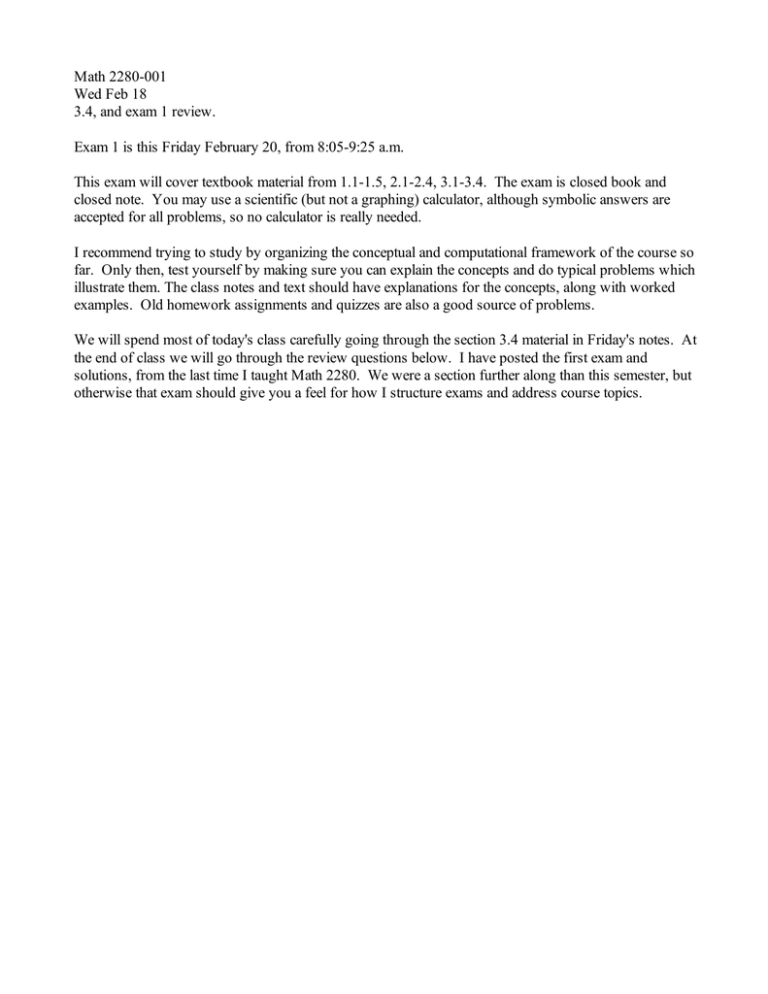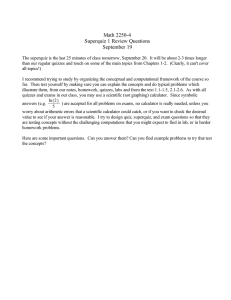Math 2280-001 Wed Feb 18 3.4, and exam 1 review.
advertisement

Math 2280-001 Wed Feb 18 3.4, and exam 1 review. Exam 1 is this Friday February 20, from 8:05-9:25 a.m. This exam will cover textbook material from 1.1-1.5, 2.1-2.4, 3.1-3.4. The exam is closed book and closed note. You may use a scientific (but not a graphing) calculator, although symbolic answers are accepted for all problems, so no calculator is really needed. I recommend trying to study by organizing the conceptual and computational framework of the course so far. Only then, test yourself by making sure you can explain the concepts and do typical problems which illustrate them. The class notes and text should have explanations for the concepts, along with worked examples. Old homework assignments and quizzes are also a good source of problems. We will spend most of today's class carefully going through the section 3.4 material in Friday's notes. At the end of class we will go through the review questions below. I have posted the first exam and solutions, from the last time I taught Math 2280. We were a section further along than this semester, but otherwise that exam should give you a feel for how I structure exams and address course topics. Review Questions 1a) What is a differential equation? What is its order? What is an initial value problem, for a first or second order (or higher order) DE? 1b) How do you check whether a function solves a differential equation? An initial value problem? 1c) What is the connection between a first order differential equation and a slope field for that differential equation? The connection between an IVP and the slope field? 1d) Do you expect solutions to IVP's to exist, at least for values of the input variable close to its initial value? Why? Do you expect uniqueness? What does the existence-uniqueness theorem say? What can cause solutions to not exist beyond a certain input variable value? 1e) What is Euler's numerical method for approximating solutions to first order IVP's, and how does it relate to slope fields? 1f) Can you recognize the first order differential equations for which we've studied solution algorithms, even if the DE is not automatically given to you pre-set up for that algorithm? Do you know the algorithms for solving these particular first order DE's? 2a) What's an autonomous differential equation? What's an equilibrium solution to an autonomous differential equation? What is a phase diagram for an autonomous first order DE, and how do you construct one? How does a phase diagram help you understand stability questions for equilibria? What does the phase diagram for an autonomous first order DE have to do with the slope field? 2b) Can you convert a description of a dynamical system in terms of rates of change, or a geometric configuration in terms of slopes, into a differential equation? What are the models we've studied carefully in Chapters 1-2? What sorts of DE's and IVP's arise? Can you solve these basic application DE's, once you've set up the model as a differential equation and/or IVP? 3a) For functions y x , why is L y dy called linear? n C an K 1 x y nK1 C...C a1 x y#C a0 x y 3b) For linear operators L, why is the general solution to L y =f given by y = yp C yH, where yp is any single particular solution, and yH is the general solution to the homogeneous problem? 3c) For the differential operator L above, what is the dimension of the solution space to the homogeneous DE L y = 0? What does this have to do with the existence-uniqueness theorem? 3d) Can you check whether collections of functions are linearly independent? 3e) What's the Wronskian matrix? How does it arise in studying initial value problems? 3f) What's the algorithm for finding the solution space to y n C an K 1 y n K 1 C...C a1 x y#= 0 (when all the aj are constants)? What is Euler's formula, and what does it have to do with this discussion? How are repeated roots to the characteristic polynomial handled? Why are the solutions that the algorithm creates linearly independent? 3g) For the application to unforced (but possibly damped) mass-spring configurations m x## t C c x# t C k x t = 0 what sorts of phenomena arise? Can you convert to amplitude-phase form for simple harmonic motion? Can you describe the important quantities for simple harmonic motion? How are damping phenomena classified? Can you solve IVPs?

